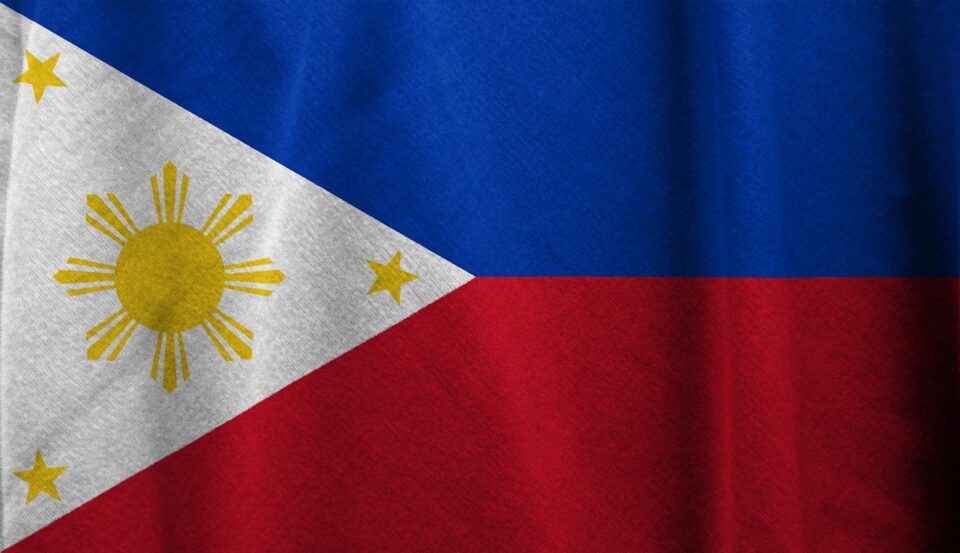
PHILIPPINES
GEOGRAPHY
The Philippine archipelago lies in Southeast Asia in a position that has led to its becoming a cultural crossroads, a place where Malays, Chinese, Spaniards, Americans, and others have interacted to forge that unique cultural and racial blend known to the world as Filipino. The archipelago numbers some 7,100 islands and the nation claims an exclusive economic zone (EEZ) of 200 nautical miles from its shores. The Philippines occupies an area that stretches for 1,850 kilometers from about the fifth to the twentieth parallels north latitude. The total land area is almost 300,000 square kilometers. Only approximately 1,000 of its islands are populated, and fewer than one-half of these are larger than 2.5 square kilometers. Eleven islands make up 94 percent of the Philippine landmass. Most Filipinos live on or near the coast, where they can easily supplement their diet from approximately 2,000 species of fish. The Philippines is part of a western Pacific arc system that is characterized by active volcanoes. Among the most notable peaks are Mount Mayon near Legaspi, Taal Volcano south of Manila, and Mount Apo on Mindanao. All of the Philippines islands are prone to earthquakes.
HISTORY
As regards the history, it was a Spanish colony for more than three centuries. This made that, despite the previous influence of the Chinese, Indian and even Islam world from the XIV century, which survives in the archipelago with about 10% of followers today, the Spanish presence out of definition in the Philippines configuration. Indeed, after the Spanish defeat on the occasion of the Spanish-American War of 1898 -thus, the constitutive act that we could qualify as clearly imperial of that new American nation, which manifests in its beginnings its desire not to want to be the same as the powers European, was to take over the overseas territories of the most defenseless European power, which was none other than the decadent Spain of the late nineteenth century-, there was a long period of American rule, only interrupted by the Japanese occupation during the Second War World, until independence from 1946.


SOCIAL CULTURE AND RELIGION
The Philippines is a country that has varied greatly depending on cultural influences, although most of these influences are the result of the colonizations they had, so the culture of Spain and the United States are the most obvious. But despite all these influences, the ancient Asian culture of the Filipinos remains and is clearly seen in their way of life, in their beliefs and customs. The culture of the Filipinos is well known and appreciated by many people around the world. Filipinos are very fond of music, use various materials to create sound and like to perform dances and singing groups. Christmas is one of the most loved celebrations by Filipinos. Families meet on December 24 to celebrate the traditional “Christmas Eve”. The new year is also celebrated by gathering all the relatives again. It is celebrated with knitted clothes and fruits on the table. Filipinos are experts in sports, the traditional one of the country is called Arnis which is a form of martial arts. Although they also enjoy watching basketball, soccer or boxing matches. The family is very important to them and they also all the complete family ad friends. The children have godparents and when the parents are not there are the grandparents who take care of the children. It is common for families to work together in the same companies. There are different social classes.
The majority religion is the Catholic, introduced by the Spanish missionaries, still keeping the Philippine Independent Church, typical of the first habitants of the archipelago. There is also Islamism, Buddhism, Confucianism, Taoism, Shintoism, Protestantism, animism and among others. Currently under the Philippine Constitution of 1987, the Philippines is a non-denominational State, that is, it guarantees with privilege all religious beliefs.
POLITICS
The Philippines is a republic with a presidential form of government where power is equally divided among its three branches: executive, legislative, and judicial. The government seeks to act in the best interests of its citizens through this system of check and balance. One basic corollary in a residential system of government is the principle of separation of powers wherein legislation belongs to Congress, execution to the Executive, and settlement of legal controversies to the Judiciary. The Legislative branch is authorized to make laws, alter, and repeal them through the power vested in the Philippine Congress. This institution is divided into the Senate and the House of Representatives. The Legislative Branch enacts legislation, confirms or rejects Presidential appointments, and has the authority to declare war. This branch includes Congress (the Senate and House of Representatives) and several agencies that provide support services to Congress.
In the current political context, Rodrigo Duterte has been elected for a six-year term in 2016, and he has launched an intense campaign against drug crime, has distanced the Philippines from the U.S. to strengthen relations with China (even though some tensions linger with relation to territorial disputes in the South China Sea), and has establish closer ties with neighbouring Indonesia and Malaysia. Combating maritime piracy and terrorist groups are the other security priorities on the presidential agenda. Duterte also intends to introduce universal health-care (currently 93%) and free education from pre-school up to a basic university degree level. During the coronavirus pandemic, despite one of the world’s longest and strictest lockdowns, the Philippines has the second highest number of COVID-19 cases and casualties in Southeast Asia, after Indonesia. Nevertheless, Filipinos continue to hold their president in high regard, as Rodrigo Duterte’s approval ratings are higher than ever, indicating most of the population agree with how Duterte has been dealing with the COVID-19 pandemic.
ECONOMY
After overcoming a deep crisis originated in the last years of the dictatorship of President Marcos, economic growth has been robust, inflation controlled, its debt has remained at digestible levels and has benefited from a powerful workforce and young. In this way, the GDP (Gross Domestic Product) of the Philippine economy in the last five years has been between 6% and 7% at all times. The Philippines’ economy is considered as one of the most dynamic economies in East Asia and the Pacific. In 2020, however, GDP contracted by an estimated 8.3%, due to the outbreak of COVID-19. Nevertheless, according to the IMF’s October 2020 forecast, GDP growth is expected to pick up to 7.4% in 2021, subject to the post-pandemic global economic recovery. Key economic drivers include solid fundamentals, a competitive workforce, a stable job market, steady remittances, and investment in the construction sector (World Bank). In its most recent January 2021 update of the World Economic Outlook, the IMF has revised its GDP growth projections for the Philippines to 6.6% in 2021 and 6.5% in 2022 (representing a difference from October 2020 WEO projections of -0.8% and +0.1%, respectively). The Philippines’ economy is based on food processing; production of cement, iron, and steel; and telecommunications, among others. According to the latest rates by the World Bank, the agricultural sector employed 22.5% of the labour force in 2020 but contributed to 8.8% of GDP in 2019, a share that has been decreasing in recent years. The Philippines is the second largest producer of coconuts in the world. However, the agricultural sector suffers from low productivity, weak economies of scale and inadequate infrastructure. Still, the government is working on restructuring and modernising the sector, and have been implementing policies such as converting government lands to agriculture use. As for mining, the Philippines are one of the richest countries of the world in terms of minerals with an unexploited mineral wealth estimated at more than USD 840 billion (Inquirer). The Philippines reserves of copper, gold and zinc are also among the largest in the world. In 2020, despite the difficulties that resulted from the pandemic, agriculture was the only sector that showed periods of growth. The industry sector contributes 30.1% of GDP and employs 19.8% of the workforce. Industrial food processing is one of the Philippines’ main manufacturing activities. The big industries are dominated by production of cement, glass, chemicals products and fertilisers, iron, steel and refined oil products. However, the industry sector was the hardest hit by the pandemic, specially the manufacturing, construction, and transportation and storage sectors. The tertiary sector – which represents 61% of GDP and employs 57.6% of the country’s workforce – has developed substantially, particularly in telecommunications, call centres and finance. Government goals for the sector include attracting investments in human resource development, design, R&D, finance, and infrastructure; bolstering manufacturing-derived services; and establishing new ecosystems linked with manufacturing (Department of Trade and Industry and Board of Investments). In 2020, the services sector was greatly impacted by the pandemic and some the most heavily affected industries were tourism, accommodation, food and beverages, and transportation.

INTERNATIONAL RELATIONS
U.S.-PHILIPPINES RELATIONS
The United States established diplomatic relations with the Philippines in 1946. U.S.-Philippine relations are based on strong historical and cultural linkages and a shared commitment to democracy and human rights. The 1951 U.S.-Philippines Mutual Defense Treaty provides a strong foundation for our robust security partnership, which began during World War II. Over the last decade, disaster relief and recovery has also become an increasingly important area of assistance to the Philippines. The United States has provided over $143 million in assistance to date to the people of the Philippines in relief and recovery efforts after Typhoon Haiyan/Yolanda devastated the country in 2013. The United States continues to support long-term reconstruction and rebuilding efforts, and has allocated over $60 million to support ongoing humanitarian assistance and stabilization funding in response to the Marawi siege. The United States and the Philippines have a strong trade and investment relationship, with over $27 billion in goods and services traded (2086). The United States is one of the largest foreign investors in the Philippines, and is the Philippines’ third-largest trading partner. Key imports from the Philippines are semiconductor devices and computer peripherals, automobile parts, electric machinery, textiles and garments, wheat and animal feeds, coconut oil, and information technology/business process outsourcing services.
Key U.S. exports to the Philippines are agriculture goods, machinery, cereals, raw and semi-processed materials for the manufacture of semiconductors, electronics, and transport equipment. The two countries have a bilateral Trade and Investment Framework Agreement, signed in 1989, and a tax treaty. There are over 600 members in the Philippines chapter of the American Chamber of Commerce, which has national reach. The Philippines and the United States belong to a many of the same international organizations, including the United Nations, ASEAN Regional Forum, Asia-Pacific Economic Cooperation (APEC) forum, International Monetary Fund, World Bank, and World Trade Organization. The Philippines is also an observer to the Organization of American States. The Philippines served as chair and host of ASEAN for 2017.
